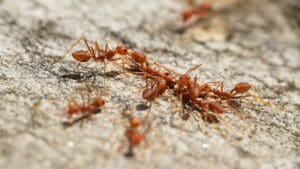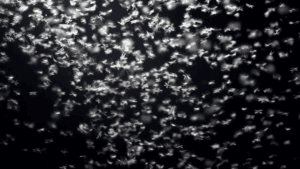When comparing crazy ants vs fire ants are two distinct species that some struggle to identify. Both are invasive and can be problematic. However, they differ significantly in behavior and impact.
Crazy ants are known for their erratic movements. They don’t sting but can damage electrical equipment. Fire ants, on the other hand, are infamous for their painful stings and aggressive nature.
Understanding these differences is crucial for effective pest control. Identifying the right ant species helps in choosing the best management strategy. This article will guide you through the key differences between crazy ants and fire ants.
We’ll explore their identification, behavior, and the risks they pose. By the end, you’ll be equipped with the knowledge to tackle these pests effectively.
How to Identify Crazy Ants vs Fire Ants
Crazy ants can be identified by their long legs and antennae. They are usually dark brown to black in color. Their movements can seem frantic and erratic, which is a standout feature. While many ant species follow a visible line, crazy ants can be seen swarming randomly.
In contrast, fire ants are predominantly reddish-brown. One of their defining characteristics is a two-segmented waist. This feature helps in spotting them amidst other ant species.

For accurate ant identification, focus on the following traits:
- Crazy Ants: Dark brown, long legs, and rapid, erratic movement.
- Fire Ants: Reddish-brown, two-segmented waist, tends to be aggressive.
Understanding these visual cues is vital. It aids in distinguishing between these pests effectively. With accurate identification, implementing the right control measures becomes simpler.
Additionally, these ants differ in size. Crazy ants are smaller, while fire ants can vary, often leaning toward the larger end. Recognizing these differences not only helps in pest control but also in understanding their habitat preferences and potential impact. These identification tips are the first step in managing infestations appropriately.
Crazy Ant and Fire Ant Behavior
Crazy ants are famous for their erratic behavior. They move quickly in non-linear patterns, often leading them in unpredictable directions. This unusual movement helps them avoid predators.
Fire ants are not as erratic but are more aggressive. When their nests are disturbed, they attack rapidly. This defensive behavior makes them a significant threat to people and animals.
Both species exhibit distinct foraging habits. Crazy ants prefer sweet substances and will often invade kitchens to find these treats. Fire ants, however, are omnivorous. They will consume proteins and sugars alike.
Here are some key behavioral traits:
- Crazy Ants: Erratic movement, love for sweets, often found indoors.
- Fire Ants: Aggressive defenders, varied diet, prefer outdoor nests.
Understanding these behaviors can help in managing each species effectively. Knowing what attracts them and how they respond to threats is crucial for implementing control strategies. By observing their habits, homeowners and pest control professionals can tailor their approaches to mitigate the impact of these pests.
Damage and Risks: What Each Ant Can Do
Crazy ants are not as threatening physically as fire ants. However, their unique ability to nest in electrical equipment is troublesome. They can disrupt circuits, leading to electrical failures and costly repairs.
Fire ants, on the other hand, pose a direct physical threat. Their painful stings can cause severe allergic reactions in some individuals. Pets and livestock are also at risk, making them a major concern in agricultural areas.
Both ant species can have significant ecological impacts. They disrupt local ecosystems by competing with native species. This competition can lead to decreased biodiversity and changes in the local environment.
Key risks associated with each:
- Crazy Ants: Electrical damage, indirect human impact, urban nuisance.
- Fire Ants: Painful stings, ecological disruption, direct physical threat.
Understanding these risks is crucial for developing effective control measures. While crazy ants are less aggressive, their potential for infrastructural damage cannot be ignored. Conversely, fire ants require careful handling due to their more direct harm to living creatures. Identifying and addressing these risks will help mitigate the challenges posed by both crazy and fire ants.
Pest Control Strategies for Crazy Ants and Fire Ants
Effectively managing crazy ants requires a multi-faceted approach. Baiting is essential to draw them away from sensitive areas. The use of sweet-based baits can be particularly effective due to their attraction to sugars.
Exclusion methods are also vital in controlling crazy ants. Seal entry points in buildings to prevent their movement indoors. Regular maintenance and monitoring ensure these barriers remain effective.
Fire ants necessitate different strategies due to their aggressive nature. Chemical treatments are commonly employed for quick results. Broadcast insecticide treatments and mound drenches can significantly reduce populations.
An integrated pest management (IPM) approach balances various control methods. This approach minimizes the environmental impact while effectively controlling ant populations. Key strategies include:
- Crazy Ants: Baiting, exclusion, regular maintenance.
- Fire Ants: Chemical treatments, mound drenches, IPM techniques.
Consulting professional pest control services can provide tailored strategies for severe infestations. Professionals bring expertise in identifying ant species and their behaviors. They can offer sustainable solutions that address both immediate and long-term ant control needs. Understanding these strategies will help protect homes and gardens from the disruptive presence of both crazy ants and fire ants.
Crazy Ant vs Fire Ant Comparison Table
| Characteristics | Crazy Ants | Fire Ants |
|---|---|---|
| Appearance | Reddish-brown, small hairs on body, up to 1/8″ in length. | Dark reddish-brown, visible stinger, range from 1/8″ to 3/8″ in length. |
| Behavior | Known for their erratic, “crazy” movements with no visible trailing. | Highly aggressive when disturbed, painful sting that can cause allergic reactions. |
| Hazards | Do not sting. Use formic acid to neutralize invading or competing pests. | Stings with a venomous sting, which causes a painful burning sensation. |
| Nesting | Will build nests in a variety of locations, including inside buildings. | Typically build mounds in open, sunny areas. |
| Impact | Known to cause significant damage to electrical equipment and for displacing native ant species. | Known for their painful sting, aggressive behavior dominates competing ant species. |
| Region | Originated in South America. Found in the Gulf Coast of the US, with a heavy population in Texas. | Prominent in the Gulf Coast area of the US, but seen across the country. |
Frequently Asked Questions
What attracts crazy ants to my home?
Crazy ants are attracted to sweet substances and moisture. They often invade homes searching for food and water sources. Ensuring that kitchens and bathrooms are free from spills and leaks can help prevent infestations.
How do I identify a fire ant mound?
Fire ant mounds are large and dome-shaped. They do not have a central opening like other ant nests. If disturbed, the ants quickly swarm out in large numbers, becoming aggressive.
Are crazy ants dangerous?
Crazy ants do not sting, but they pose other risks. They can nest within electronic devices, potentially causing costly damage. While they are less aggressive than fire ants, their ability to form large colonies makes them difficult to eradicate. For pest control, it’s important to address infestations promptly to prevent damage.
Know The Ant, Choose the Right Approach
When dealing with crazy ants or fire ants, knowing their differences is vital. Each ant species presents unique challenges and requires distinct solutions.
By understanding their behaviors and the damage they can cause, you can determine the best pest control strategy. Whether you opt for DIY methods or professional services, addressing the problem early is crucial. With the right approach, you can protect your home and maintain a pest-free environment.





